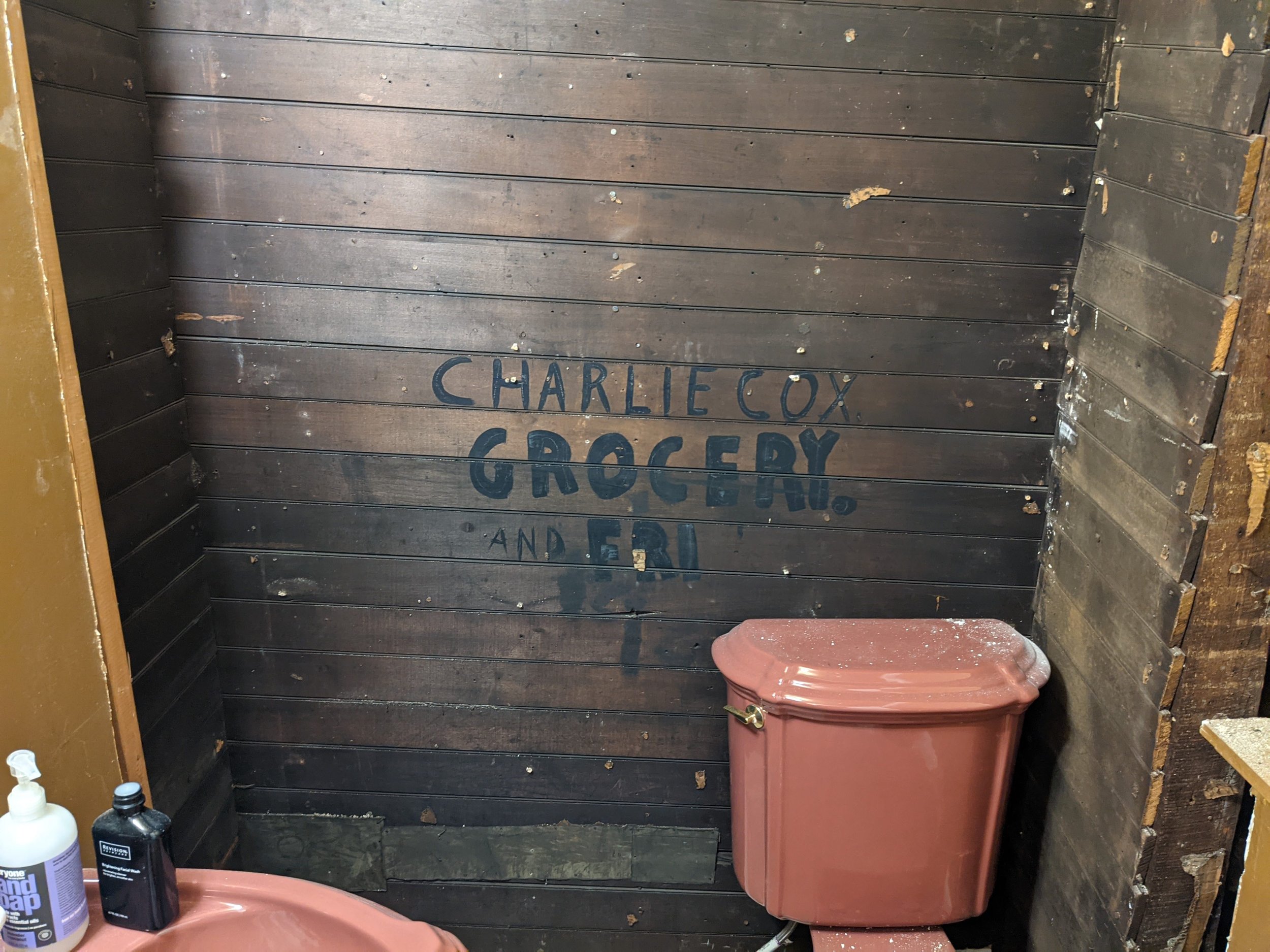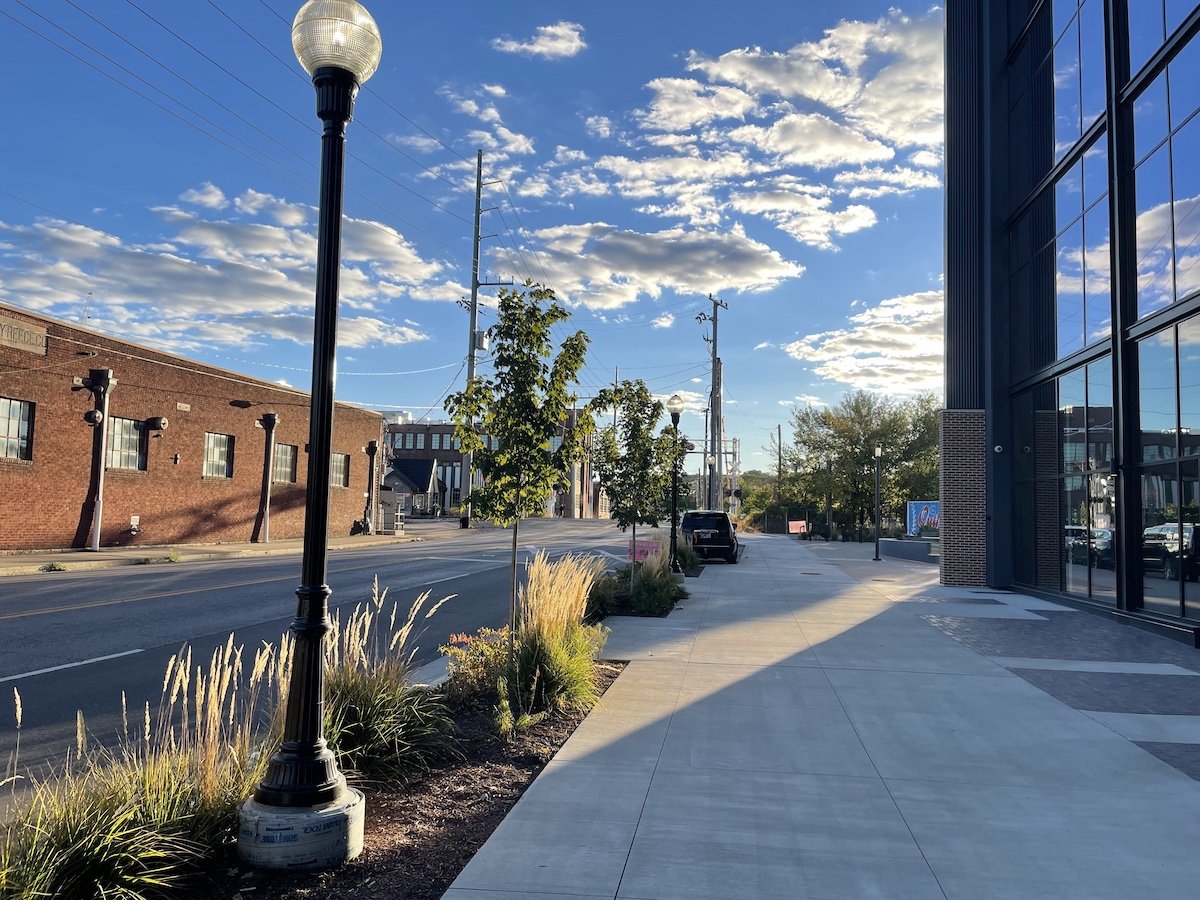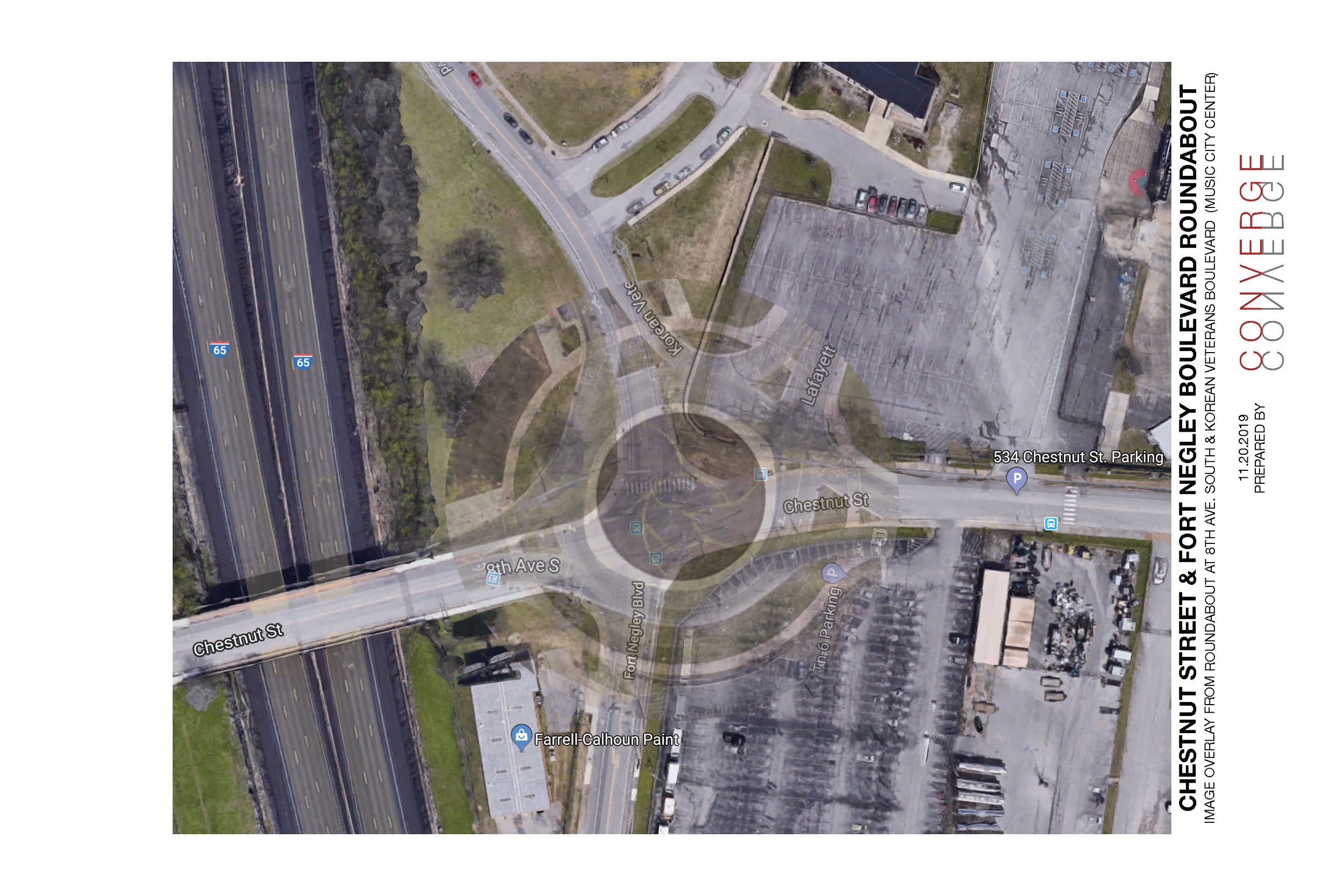Safer Chestnut Street
Written By Jon Sewell, Community Member + Eric Malo, Co-Founder of Converge
Visuals By Taylan Tekeli, Design & Research Assistant
4 min read Chestnut Street is one link of a longer cross-town connector that is used intensively every day by people from many neighborhoods, walks of life, and with varied needs and experiences in relation to the city. It connects diverse neighborhoods, business, and institutional districts. Thus we can envision Chestnut Street as part of a multi-modal jeweled necklace stretching across South Nashville, with each neighborhood and business area, each park, historic area, and cultural organization, each civic institution, educational center, and social entity adding their unique glimmer and spark to the greater whole.
Figure 1: Context map showing the focus area in orange and important multimodal connections in yellow.
Chestnut Street ties neighborhoods together
Jon Sewell:
Recently renovating part of our corner-lot house we discovered evidence of a grocery store in a bedroom that faces the side yard
Living in the oldest house on Chestnut Street has provided me with great insight into the history of the literal crossroads between the neighborhoods in South Nashville. One long street—from Wharf Ave to Chestnut St to Edgehill Ave—follows a vast string of neighborhoods from Napier to Chestnut Hill (formerly Cameron-Trimble), from Chestnut Hill to Wedgewood-Houston, Wedgwood-Houston to Edgehill to Music Row and Vanderbilt. This necklace of public access has seen diverse modes of transportation—horses, wagons, street cars, and horseless carriages—along residential roads. Many of these neighborhoods had a racially integrated history dating to before the civil war; European immigrants, rich and poor, lived alongside Black families in economic and demographic diversity. Small community-based street layouts allowed access to neighborhood pharmacies and grocery stores, often inside of homes.
As these main streets turned to more industrial use, especially near train tracks, Chestnut Street still tied all these neighborhoods together, but as cars became king in Nashville, the pedestrian experience deteriorated. Historical precedent indicates that it can be a people-centered connector again. However, we have some work to do to return to a Chestnut Street that once again encourages transportation mode equity.
The Wharf-Chestnut-Edgehill thruways crosses major intersections with medium and high-injury network crash data (Metro Nashville Vision Zero)
Today, some of the street includes unnecessarily wide swaths of asphalt and faded striping that lends itself to dangerous speeds and all too frequent accidents. As we reclaim walkability, accessibility, living locally, and striving for safer roads—where one death is too many—I think we can re-envision this connecting necklace to highlight some of its community pearls. In these rapidly changing neighborhoods, we have an opportunity right now to embrace the right of way as more than just a drag strip but as something that can tie communities together.
From left, Eric Hoke, Jon Sewell, and Peter Bird talking about road safety, roundabouts, and DIY trails where sidewalks should be in October 2019. [Photo by: Eric Malo]
Market forces and misguided top-down municipal planning could have driven residents out of this rapidly developing area, however I’ll share the perspective of those who stayed. The current transformation comes with plenty of economically stressful forces that are reshaping places community members didn't help make, but with rapid redevelopment there is always opportunity. We should harness resources that could return walkable design to this string of streets and reimagine the right of way as something that allows for multi-modal connectivity.
Moreover, there's a historical thread here whose stories are often simplified or misinterpreted by local outlets but the vestiges of which continue to bear witness to future possibilities. Reclaiming that history by right of way can be done economically, thoughtfully, and with drastically improved safety In a way that elevates the local culture and helps tell our story.
As a Neighbor of Wedgewood Houston
Eric Malo:
As a neighbor of Wedgewood Houston that frequently walks and bikes on most of our local streets, alleys, and byways, I have a local perspectives. However, as a father raising 2 children to have a similar perspective on walking and biking, I am intimately aware of the nuances of the streetscapes in this area. I have an active 11-year old boy that walks and bikes on all surfaces, whether it’s through gravel or over potholes and a six-month-old infant that must be carried or pushed in a stroller. While we enjoy every outing through the neighborhood, including the grit and grind that add a rugged romanticism to our adventures, it is unfortunate that these streetscapes are lacking from both the perspectives of a pedestrian and a cyclist. We should strive for improving the infrastructure to provide a safer and more beautiful experience for all as we walk into the future.
State of Pedestrian Infrastructure in Wedgewood HoustonEric Malo taking his six-month old daughter on walks in Wedgewood Houston in October 2022
Infrastructure that supports safe, convenient, and often necessary movement by people without motorized vehicles exists only on a few streets within the neighborhood, and is lacking, limited, or in disrepair throughout much of it. Sidewalks don’t exist on many streets, but where they do, they are usually 1) too narrow, 2) crumbling, 3) close to the street, 4) lacking good tree cover, 5) littered with debris, 6) have an inordinate amount of poorly constructed curb-cuts, and 7) often end abruptly in a ditch, the grass, or at a utility pole.
There are very few public benches, and a pedestrian is hard-pressed to find those we have. They are at bus stops or exist through the efforts of a few active neighbors. Only recently have a few privately-funded bike racks been installed only thanks to local development and zoning requirements. Public lighting is limited to harsh, over-bright streetlights intended to light the pavement for vehicles and which do not create a pleasant ambiance for people. I could go on, but hopefully, this paints a picture of the poor state of the infrastructure for pedestrians within Wedgewood Houston. In addition, cycling infrastructure virtually does not exist, so people are left to risk their safety while sharing pavement with motorized vehicles.
For too many decades—probably since the streetcars were ushered out by 1941—the growth of Nashville‘s transportation infrastructure has focused almost exclusively on roads for private, motorized, vehicular transportation. However, recent years have seen significant growth that finally demands a focus on the people that live in the city and the many ways that we would like to move about our neighborhoods.
New Developments are an Opportunity for ImprovementA view of the sidewalk on Chestnut Street in front of the brand new Nashville Warehouse Company in October 2022
Where new developments have been completed, we are now fortunate in most cases to have improved infrastructure from curb to building. This usually includes proper sidewalks and planting strips, accessibility ramps, and bike racks. Several notable projects are 1260 Martin Street by Core Development as well as The Nashville Warehouse Company on Chestnut and 4th by AJ Capital. These projects can act as solid precedents for new streetscape improvements in the future.
Chestnut Street is one of the streets in our neighborhood that does have sidewalks; however, except at the new Nashville Warehouse Company, the street's current infrastructure was built to predominantly usher motorized vehicular traffic across the neighborhood quickly, without much care for the neighborhood as such; nor for stop signs, crosswalks, traffic signals, speed limits, pedestrian safety, etc. Furthermore, its current condition seems to be an unintentional result of too many years of neglect and entropy, on top of the poorly designed infrastructure, with inadequate attention toward the pedestrian experience.
Therefore, we should no longer accept the poor conditions and lack of proper people-oriented infrastructure, and we should strive for new best solutions for all people moving forward.
A Jeweled Necklace for South Nashville!
Of course, right now it is desirable for people to be able to move safely and efficiently across the city in private, motorized vehicles, but it is also desirable for Nashville that people be able to safely, comfortably, and dependably walk, bike, stroller, jog, rollerblade, or scooter across the city. As with many areas throughout the city, Chestnut Street and its extensions are at a critical point in time due to significant private development along its length, aligned with public intentions and efforts for improvement. We are presented with a gleaming opportunity to envision and create a beautiful, safe, efficient, multi-modal street that is a meaningful addition to the city and which can be cherished for generations to come.
This jeweled necklace should be developed per Metro's Green and Complete Streets Policy, to be a "safe, reliable, efficient, integrated and connected system... that promotes access, mobility and health for all people, regardless of their age, physical ability, or mode of transportation..." and accommodates "all users of the transportation system, including, but not limited to, people who walk, bike, take transit, drive, transport freight, operate emergency vehicles, or own adjacent land. Furthermore, the system improves environmental quality through the inclusion of green street elements such as street trees, swales, native plants, and grasses, that reduce stormwater runoff, optimize stormwater quality, and enhance natural environments."
long term Vision Focal Points
First and foremost, I think people from impacted and involved civic organizations, neighborhood groups, and institutions need to have the right conversations with people in the right Metro Departments and private development groups that are active along the corridor. The outcome of this street should certainly not be left up to Metro employed nor independently contracted traffic engineers to determine.
Second, these conversations should focus on a true long-term vision for the corridor - 100 years would be an appropriate starting point - and have the intent of developing a thoroughfare worthy of a great city, not simply a conglomeration of asphalt, concrete, and steel. As we develop a vision, we should employ the methods of Tactical Urbanism to test ideas and experience short-term successes. As these temporary efforts bear fruit, public and private capital should be employed to implement permanent solutions.
I will present two specific project ideas here that I think are highest-level problems that should be addressed early as highest-level opportunities to create unique solutions.
A Roundabout at Chestnut Street and Fort Negley BoulevardThe perspective of potential for a roundabout at the intersection of Fort Negley Blvd and Chestnut St
Aerial perspective of the intersection at Chesnut St and Fort Negley Blvd
Aerial perspective of potential roundabout solution at the intersection of Chesnut St and Fort Negley Blvd
This intersection is currently a loose link along the Chestnut necklace; the Right-of-Way is gigantic, the pavement area within the intersection is equally extreme, the street striping has mostly worn away leaving little guidance for traffic, and the visibility due to the street slopes is difficult. All of these challenges produce an unsafe and unattractive swarth of pavement immediately adjacent to one of the most important historical and cultural locations within our City - Fort Negley Park - which is currently undergoing a long-term Masterplan project. This presents us with an epic opportunity to create a Roundabout at this intersection that will solve traffic problems while also creating a fantastic urban node that can be a gateway between Wedgewood Houston and Edgehill, a way-finding element along the Chestnut corridor, and a monumental entrance into the Fort Negley Park and Cultural Campus. In addition to Complete Street detailing, this Roundabout should incorporate beautiful landscaping and hardscaping that complements the park, as well as public art to define this node as a meaningful terminus along the Chestnut Street Corridor.
Above images show Nashville roundabout spacial comparisons made by CONVERGE
A Two-Way Cycle Track on the North Side of Chestnut StreetA necklace of this significance should have multiple strands. In addition to the strands for motorized vehicles and pedestrians, we can envision a continuous strand dedicated to cyclists. For much of the length of Chestnut Street as well as sections of Wharf Street and Edgehill further along, the North side of the street has quite a number of notable Nashville entities - from Lead Academy at Lafayette, to Fort Negley Park, to Rose Park Middle School and Rose Park at Edgehill - as well as fewer curb cuts and intersections.
Plan view of an ideal two-way cycle tracks from NACTO
These landmarks provide the logical basis for utilizing that side of the street for a two-way, dedicated Cycle Track that is separated from both pedestrian circulation and the pavement of the street itself with a planted median. Combining both lanes of cycling on a single side of the street reduces the total width required allowing space for a median, which can be planted with trees and other greenery to add an additional layer of nature and shade to the street. A dedicated track such as this indicates a true commitment to multi-modal transportation and improves the quality of the streetscape by significant degrees.
Before and after of chestnut with two-way cycle track
Photos from Jon Sewell of a two-way cycle track from Washing DC
Finer Details for Streetscaping Visions
Streetmix view of Chestnut Street with a two-way cycle track
Diving deeper into the design of Chestnut Street, we should give attention to both the large-scale elements of the thoroughfare and the finer details of the streetscape. Where space allows, such as along Wharf Street, we should develop the Right-of-Way as a true boulevard with a planted median and large street trees to provide shade. In other areas, smaller medians and sidewalk strips with greenery and understory trees can add environmental enhancements and natural beauty.
We should create long vistas with termini at prominent intersections and notable landmarks. We should consider roundabouts and other significant street infrastructure as opportunities for beauty and placemaking. Wayfinding from the roundabout going North on Fort Negley Boulevard from Chestnut will provide future access to expanded centers at the Fort, the children's museum and easier access to the City Cemetery. Wayfinding going south will provide access to a reimagined off campus Vanderbilt site and secondary access to new developments on Hamilton in Wedgewood Houston.
Developing finer details of the overall streetscape such as pedestrian lighting, benches, paving materials, bike racks, and so on, will add levels of functionality, a sense of human scale, an appropriate pedestrian- speed rhythm, and visual texture. These thoughtful amenities will produce true enjoyment for the user and a rich and beautiful experience of place.
Broader community engagement on this topic with meaningful conversations and dedicated efforts of community leaders, developers, and Metro staff can push forward a bright vision for Chestnut Street as part of this important cross-town connector - a jeweled necklace for South Nashville!
Help us identify other locations where we can bring solutions to pedestrian safetyIn addition to this street development, Nashville could benefit from other creative solutions where pedestrian safety is not the priority. If you to think of an additional location for this solutions, please comment below!



















